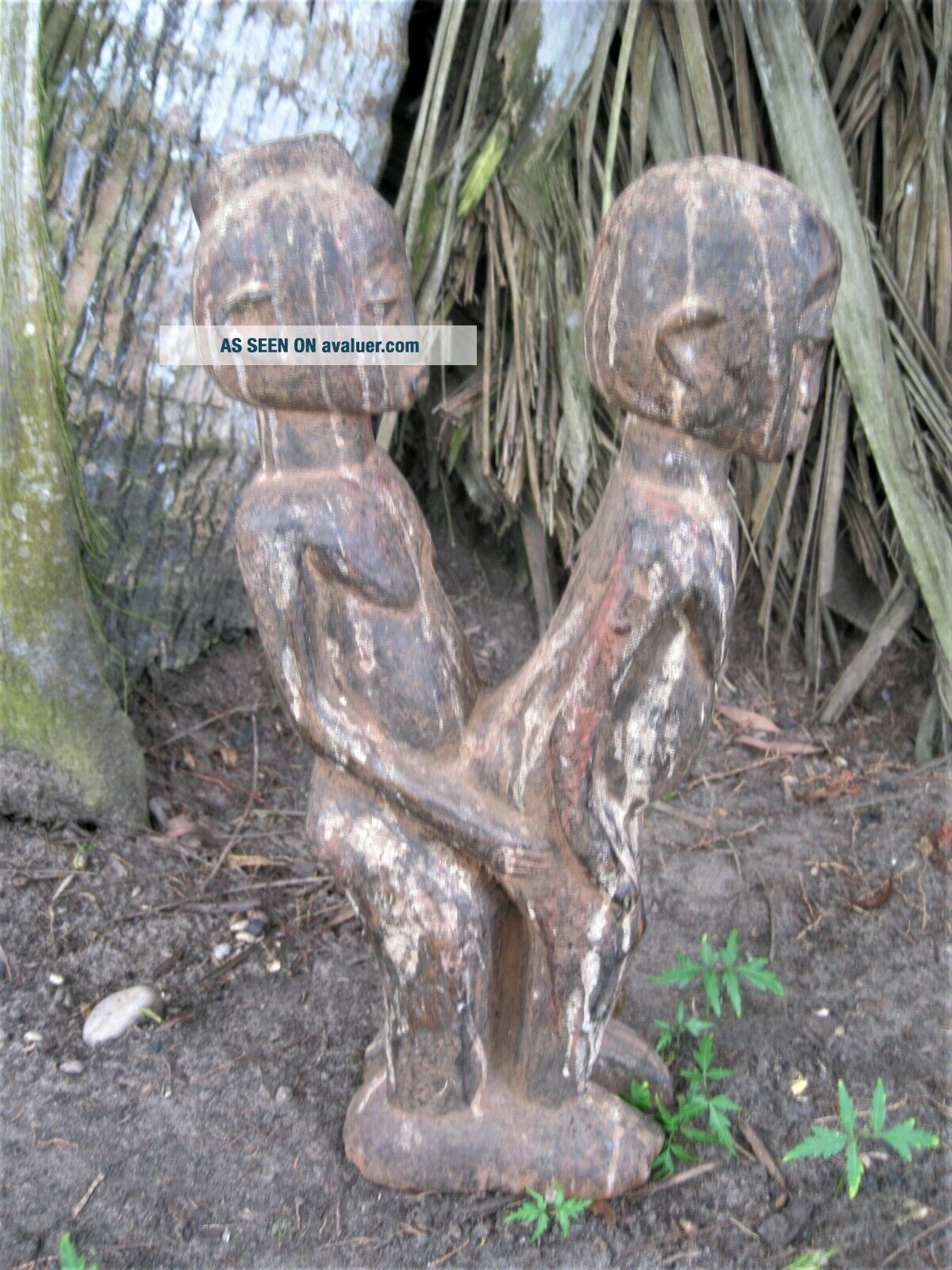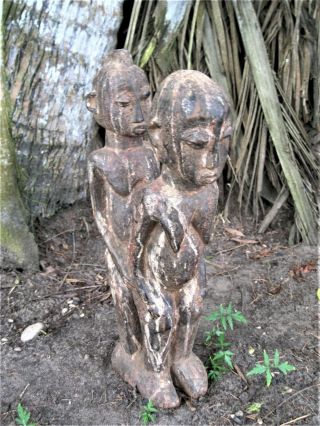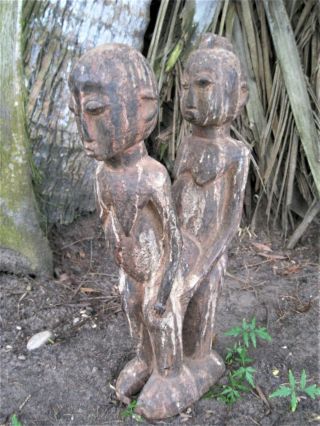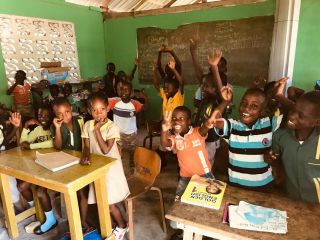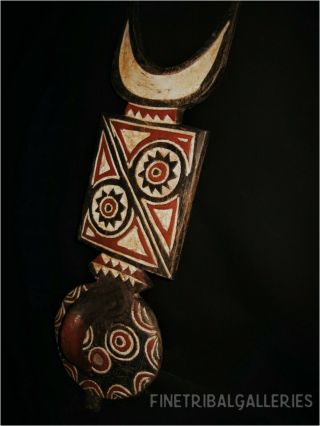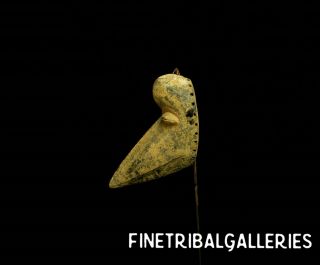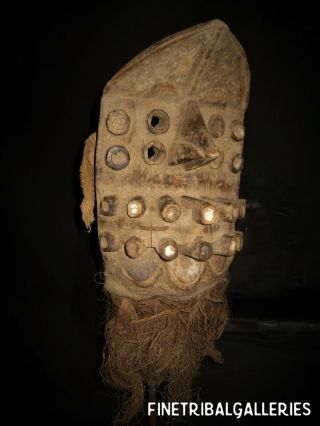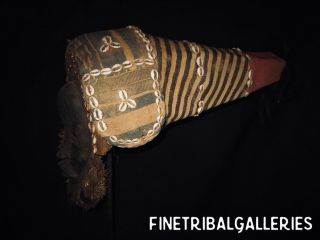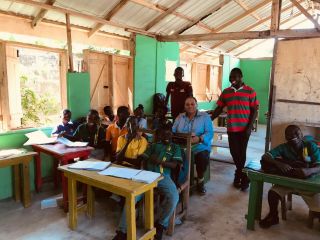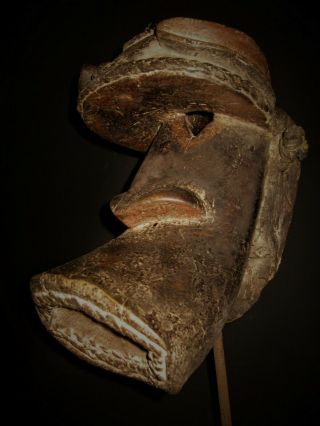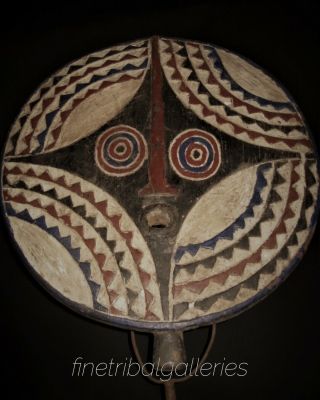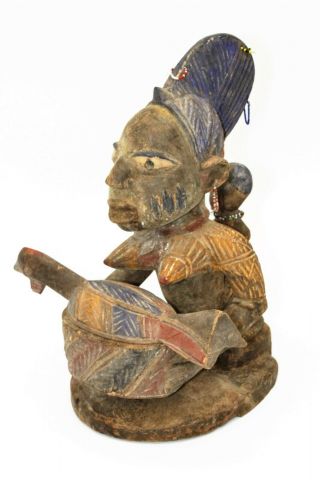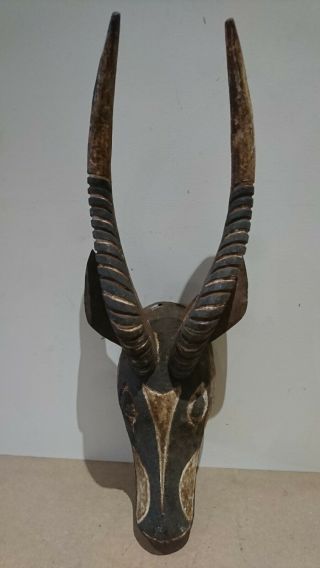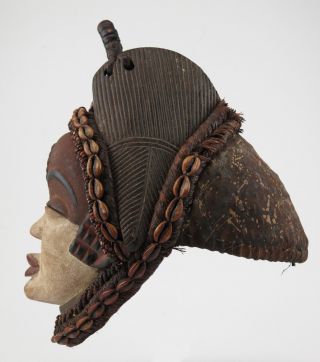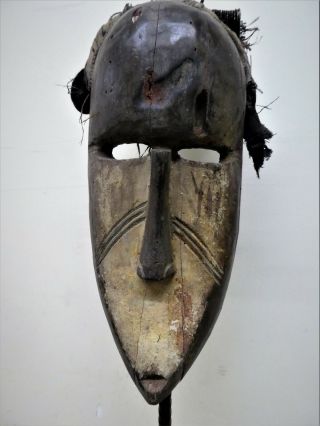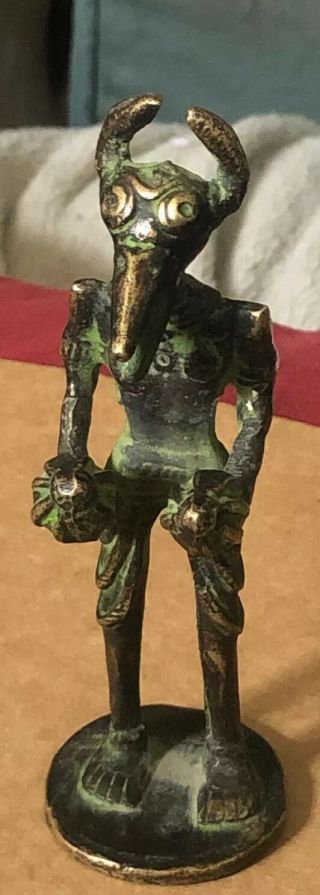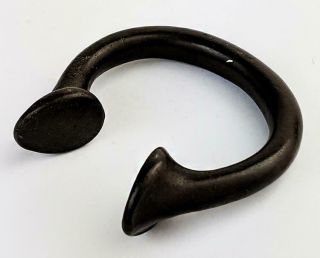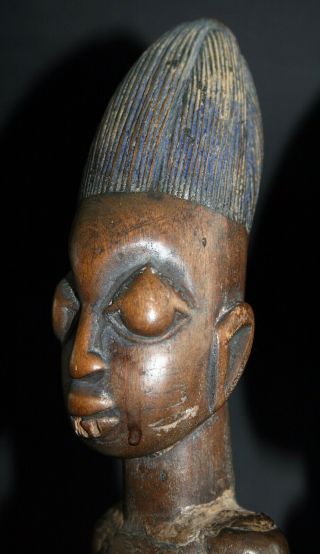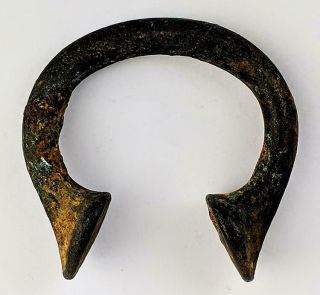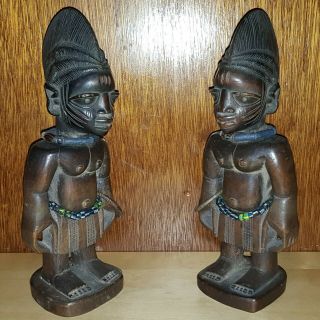Fine Tribal Galleries - INTIMATE LOBI FIGURES - BURKINA FASO - C1930 - 40
Item History & Price
| Reference Number: Avaluer:5503 | Region of Origin: African |
| Primary Material: Wood | Product: Carved Figures |
| Original/ Repro: Original | Age: 1900-1940 |
NOTE: EVEN THOUGH WE ARE SELLING THIS ON 'AUCTION' ON BEHALF OF A BIG COLLECTOR, THERE IS STILL "NO RESERVE" PRICE ON THIS ITEM. OFFERS CAN BE MADE. PROCEEDS GO TO OUR AID PROJECTS(Most of our Auctions do not have any reserves put on them, and many start from just a penny!!!)
APOLOGIES TO ALL OUR REGULAR BIDDERS AND CUSTOMERS ON EBAY. WE HAVE NOT HAD ANY LISTINGS UP SINCE THE MIDDLE OF LAST YEAR. THIS WAS DUE TO OUR UK AND EUROPEAN TEAMS BEING AWAY, BASED PRIMAR...ILY IN WEST AFRICA WORKING ON OUR LATEST PROJECTS - BUILDING / EXPANSION OF OUR TWO INFANT SCHOOLS IN VILLAGES. THE PROJECTS ALSO INCLUDED DIGGING BORE HOLES (WATER WELLS) AND PROVIDING SANITATION.
WE ARE NOW BACK AND ARE EXCITED TO PRESENT OUR UNIQUE FINDINGS FROM WEST AFRICA!
ANY ‘SIGNIFICANT’ DAMAGE WILL BE POINTED OUT IN THE DESCRIPTIONS OR SHOWN IN PHOTOGRAPHS IN OUR LISTINGS.
__________________________________________________________________________________________________________________________________
THE FINE TRIBAL GALLERY COLLECTION Authentic African Antiquities & Artefacts By Dr. Stephen M Thanni
LOBI FIGURES
Item Number: 109Originates from: Village in the South of Burkina FasoTribe: LobiApproximate age: c1930-40Measurements (cm): Height 51 Width 12 Depth 26Materials: WoodCondition: Weathered; fair condition
FREE RETURN WITHIN 60 DAYS, WITH 100% REFUND IF NOT HAPPY FOR 'ANY' REASON!!
Lobi Figures are the enigmatic, brooding sculpture that protect the Lobi people of Burkina Faso. Ranging in size from 7 - 47" high, most are frontal, symmetrical and timeless sentinels expressing the traditional beliefs of the Lobi. Several, such as these couple figures, depart from the norm with animated gestures, asymmetry or a great degree of symbolic abstraction. The figures were placed on family altars in the thilda, a small sacristy or room in each dwelling. Each figure was not a representation but an actual spirit, or tibil thil. It protected the family and home from illness and other misfortunes. The spirit could also be used for divination; it could demand offerings and additions of other figures. The accumulation of statues on a family altar gave social status and were passed on from father to son. The collection we have on exhibit is large and varied. Most were frontal and symmetrical, but some have unusually animated gestures. Hamill
LOBIAround 1770 the Lobi migrated from Ghana into Upper Volta. A hundred years later some of them crossed the border into what is today the Ivory Coast on their search for uncultivated land. That is why today only about 60% of the total 160, 000 Lobi now live in the southwest corner of Upper Volta, while 65, 000 live in the northern Ivory Coast (see Labouret, 1931:27‑29, 1958:16‑17, 37 and Fiéloux, 1976:44‑49). The whole area is savanna grown over with bushes and trees. The savanna lies as a middle strip between the Sahel zone in the north and the jungle belt in the south, and extends from west to east through all West Africa. The Lobi are hoe-farmers and live mainly on millet, sorghum and corn (see ill. 5). They breed small livestock and horned cattle, though this is not done for food but mainly for dowries, payment of fines, and sacrifices. Today hunting and fishing supplies little meat because animals have become rare after Europeans brought guns into the country. Therefore the daily millet or corn pudding is generally accompanied by various sauces, which are usually saltless and often bitter tasting. They are prepared by the women out of fruits, leaves and roots which they either planted or gathered from bushes. Traditionally they eat only one meal a day, in the evening after work. The Lobi live in cool mud huts with narrow doors and windows. Their flat roofs are surrounded by raised walls, giving them the appearance of roof terraces, and they remind one of small castles. Until recently, the Lobi were very warlike. Vengeful fights were a common happening, one village fighting against another village, one family group against another. The French colonial regime which had to face a strong and persistent resistance against their efforts to colonialize the Lobi, could scarcely put a stop to this state of permanent unrest and insecurity (see Kambou, 1971, Pere, 1979:397ff). In every house (tyor) lives a minimum family unit (see ill, . 24): a “family chief” (tyuordarkuun), who has absolute authority over the other family members (tyordara), his wife(s), his married sons, who he did not yet “separate” (le) from him, i.e. whom he did not yet grant economical and social independence and who therefore have to work for and live with him, as well as his son’s wives and the unmarried children. The men of the house clear the fields and prepare them with hoes for the sowing. The women sow and bring home the ripe cobs carrying them in baskets on their heads. In addition, the men do most of the maintenance work and the crafts. They build and repair houses, carve wood, forge iron and work as brass founders. The women on the other hand take care of the housework. They collect water from a nearby brook, gather wood and carry it home; they crush the different grains in mortars with long, heavy pestles and pulverize them, a time consuming and heavy work, and they prepare meals and finally take care of the small children. In their spare time, they brew millet beer, make pottery and weave baskets and mats. They sell their products themselves and the income is at their disposal. The Lobi don’t do any other kind of weaving. Many of these activities are only done during one season. In the rain period (April through October) most of the fieldwork is done, leaving only a little time for other things. During the dry season (November through March) all the other duties and entertainments can be done; repairs and crafts are made, one visits friends and relatives and especially goes to markets, parties and funerals. There they dance, are exuberant, drink fresh brewed millet beer, flirt with women and get to know new people. These kinds of gatherings, as seen on markets, parties and funerals, are otherwise rare in Lobi culture. The “villages” (di) for example do not have village centers or community houses where all inhabitants or even the men of the village can meet. The houses stand far apart (between 50 to 800 meters) and seem to be disbursed randomly over the land. This impression is so strong, that as a visitor, being Lobi or European, usually one cannot tell where one village ends and another village begins. But in spite of this one can talk about villages in the Lobi culture. Why? A village unit is not based on topographical factors as in Europe, but on a system of groupings of neighboring houses living under a certain “thil” (plural “thila“), i.e. an invisible being with supernatural powers and abilities. The individual thil, being the head of the village, gives to the inhabitants of that village the norms (rules) for behavior that have to be followed strictly. These norms are given through a soothsayer. Only rarely do the thilacommunicate in a different way than through a soothsayer. If one of these norms is broken, the thilapunishes that person by making him or somebody in his immediate surroundings ill or bringing bad harvest, accidents or other calamities on that person; they may even kill him. If an extremely important norm has been neglected in very careless way, the thila can even punish the whole village by bringing epidemic into the village or by holding back the rain that is so essential for fields, animals and people. With that the thila is punishing the whole community for an offense against a norm that possibly only one of the villagers committed. What are the behavior norms that a thila ordains? Since these precepts are always formulated in the negative, the Lobi call them “prohibitions” (soser). The prohibitions of one of the village thila could be: You shall not hurt or kill a member of your village, you shall not steal from them or seduce their wives, you shall not cause them any harm, neither in a physically visible nor magically invisible way. The village thil though will also regulate the behavior of the villagers with prohibitions in regards to certain animals, plants, foods, even objects. For example, the thil of Korhogo, a village close to Wourbira, prohibits that long mats (see ill. 4) be taken into his territory. Therefore the people of his village) contrary to other Lobi have to sleep on short mats and wrap their dead in short mats when they inquire of them the cause of their death (see ill. 17). And if people from neighboring villages just bought long mats at a market, they may not cross through Korhogo on their journey home, otherwise the inhabitants of Korhogo ‑ and only they ‑ risk the sanctions of their village thil. Let’s summarize: we call a group of neighboring houses a village when it has a common thil and therefore the same norms. These norms, or as the Lobi say prohibitions, regulate the life of the people with each other and their behavior towards certain animals, plants and objects. The village thil creates through these norms the social and political order as well as a feeling of togetherness and trust, which is so necessary in order for the people to live, and in light of the production methods practiced in field and house (and before in war) work together efficiently. The village thil is called dithil (di, ”village”). He is personified through a shrine on the village territory (see ill. 32), and a priest, the so called dithildaar (“man of the dithil, ” often called Lord of the Earth in the ethnological literature) It is this priest who receives the prohibitions of the dithil through a soothsayer and who then passes it on to the members of the village. He is responsible for communication between the villagers and the dithil. The Lobi have a lot of other thila (how these other thila are personified and taken care off will be discussed later). Many of these thila are also heads of social groups and put prohibitions on them that can be different in each case. (art of burkinafaso)_________________________________________________________________________________________________________________________________________
Much of the profit raised from this sale will go towards helping some impoverished children and villagers in Cote d'Ivoire, Liberia and Ghana. We support two orphanages, as well as several villages in West Africa to whom we supply seeds, food and clean water solutions. We also run projects which include provision of anti-Malaria medicines and nets.We have recently aided in building two schools in remote villages, along with wells and sanitation facilities.
Please see photographs towards the end of our listings of some of our recent aid efforts. ______________________________________________________________________________________________________________________________________________
We ship ALL of our pieces from the UK
Tribal Pieces are packed carefully by FTG, and usually shipped ‘24-48 hours TRACKED delivery service’ in the UK by our courier. Normally, PARCELFORCE or DHL are used for International Deliveries. Requests are welcomed from customers as to your specific postal/customs requirements.Packages are typically insured during transit and will often need to be ‘signed for’. ______________________________________________________________________________________________________________________________________________ Furthermore, please note: all of FTG masks and figures have been 'treated' by African customs fumigation teams, and have permission from relevant museums to export all of the tribal pieces to the UK ______________________________________________________________________________________________________________________________________________
Track Page Views With
Auctiva's FREE Counter



